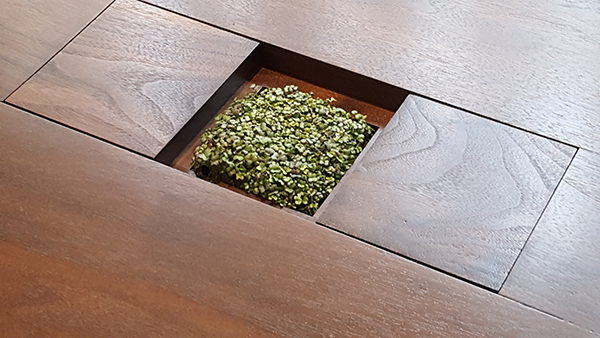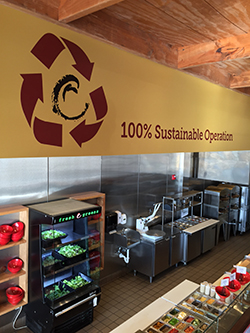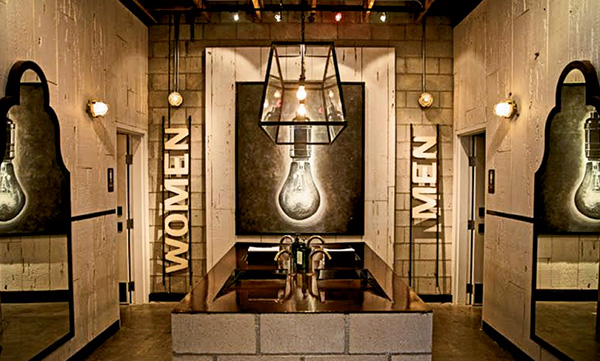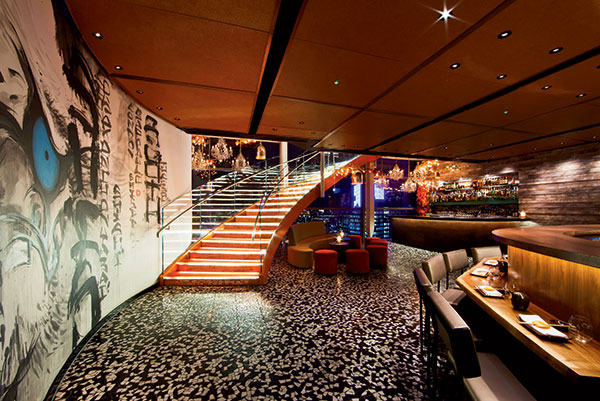Green can mean a lot of things these days. In the restaurant world, it can mean growing your own food on-site, partnering or even managing local farms, installing energy-efficient equipment, using reclaimed wood and other sustainable materials, composting, recycling, using LED lighting and more. Here’s a look at four restaurants with some unique interpretations of what it means to be green.
Temporis
Location: Chicago
Type: Full-service independent
Average check: $50-$75

More chefs are going beyond local sourcing of ingredients by building their own gardens on rooftops and in basements, like Temporis has.
A passionate gardener with a true green thumb, Co-Owner Sam Plotnick worked with a local urban agriculture company to build a multilevel hydroponic garden in his basement storage area, complete with self-made seed pods using burlap from coffee bean sacks, an irrigation system and grow lights. The garden has three vertically stacked levels providing about 36 square feet of growing space under the lights. Temporis has an additional 12 square feet of propagation space and about 20 square feet of a deep water growing system.
Grown using a nutrient film technique, the propagation space is the first step in the growth process. The seeds receive a little moisture but no sunlight for several days. This simulates the effect of being buried in soil, causing the seeds to sprout, develop root structure and grow stems as they attempt to reach sunlight.
The seeds, still planted in the burlap, are then transferred to the main growing space, or shelving unit, with 24-hour timed lighting and systems that wet the plants with nutrient-rich and pH-balanced water. Plotnick propped the shelving unit up on an angle on one side so the water trickles down just enough to saturate the burlap and then run off into a drainage system. There, the greens bloom, and it’s a quick turnaround — no more than three weeks before they can be cut with scissors and used fresh.
Currently, Temporis is growing Scarlet Frill mustard greens, beet greens, micro celery, micro scallions, sunflower sprouts, lemon balm, dark opal basil, micro fennel lettuces, Red Rambo radish greens, micro chervil and other mini greens. The main growing space is designed to grow the microgreens, which generally don’t grow more than 3 inches tall.
For the deep water system next to the shelving unit, Plotnick uses big plastic tubs with holes cut out for larger plants like lettuce, tomatoes, berries, hops and even corn to sit in standing water. Two air pumps add oxygen like in a fish tank.
Plotnick is also working on growing corn sprouts, purple kohlrabi, greens like mizzen and shies, and even strawberries.
“For a 20-seat restaurant, we need something cheaper and fresher than ordering from other farms, and I can still get the full variety with our system,” says Plotnick.
The fine-dining restaurant’s 10-course tasting menu features the microgreens and other herbs grown downstairs.
As a decorative touch in the dining room and to show diners what they are eating, Plotnick worked with an architecture firm to build wooden tables with square cutouts in the center that can either be covered by a wooden lid or opened up to hold one of the microgreen squares.
At Temporis, custom-built tables feature a panel that can display microgreens grown on-site.
b.good
HQ: Boston
Units: 54
Type: Fast-casual restaurant serving breakfast, lunch and dinner
Average check: Under $10

Expanding fast-casual chain b.good recently entered a two-year partnership with the city to manage Hannah Farm on one of Boston Harbor’s islands, about a mile from the city.
As part of the agreement, b.good can use produce harvested from the farm for its Boston restaurants, but 75 percent is earmarked for the cafeteria at the summer camp on the island for kids in underserved neighborhoods.
“We have always told the tale about how dedicated we are to local food, and we have always had relationships with farmers, but we were really interested in getting to the next level,” says Jon Olinto, b.good’s co-founder.
To manage the acre-and-a-half farm, b.good uses its own employees as well as the campers and volunteers. They harvest the produce and send it back by boat to the city. Produce taken from the farm is also sold at a farmers market in the city, and the funds go toward a scholarship for ex-campers.
Olinto estimates the farm will produce 20,000 pounds of produce this year from the 15 crops being planted, including kale, romaine and bibb lettuces, strawberries, potatoes, sweet potatoes, radishes, green and yellow wax beans, and even quinoa.
In the original restaurant, b.good uses a chalkboard menu detailing where seasonal ingredients come from to communicate its involvement with the farm to its customers. Other locations feature a further commitment to growing their own vegetables. At one location, tomatoes, herbs and lettuces grow directly on the rooftop in kiddy pools. The Seaport Boston location features an 8-foot-by-8-foot glass-enclosed hydroponic growing room at the front of the restaurant for mint, basil and other herbs, and microgreens.
“As you walk in the front door, you see a wall of fresh herbs,” says Olinto, who enlisted an urban farming organization to help build the system about a year ago. “You have to consider the proper lighting, pest control and watering needs.”
Throughout the dining rooms of its restaurants, b.good uses reclaimed wood. For the 20 Boston locations, wood comes from mills in Rhode Island.
All the restaurant locations recycle and compost.
Crushed Red
HQ: St. Louis
Units: 9
Average check: $11-$30
Type: Fast-casual pizza and salads

Before Co-Founders Chris LaRocca and Powell Kalish make any decision, they always ask themselves, “How does this help the environment?”
Crushed Red’s commitment to sustainability starts in the kitchen, which uses as little equipment as possible to cut down on energy and water use. There are no freezers and only one midsize walk-in cooler to hold fresh product delivered daily.
For the equipment the chain does use, energy-efficient models are chosen. This includes the double-stack convection ovens used to roast chicken, corn, potatoes and other foods in-house. The chain also uses an energy- and water-efficient dishwasher and a proprietary, gas-powered stone oven to cook its signature pizzas in 90 seconds. Throughout the space, the chain uses LED lighting for energy and cost savings of well over 50 percent.
Waste management is an important part of Crushed Red’s green mission. The chain composts and recycles over 90 percent of what comes into the restaurant, according to the co-founders. Vegetable stems and scraps, trimmed protein fat and even post-consumer waste go into seven 33-gallon compost bins with locks that are then brought outside for pickup twice a week by a third-party vendor.
The founders focus on using linens and traditional silverware as much as possible to cut down on paper waste. For takeout, catering and delivery (the latter of which was introduced in 2016), the restaurant uses 100 percent compostable and recyclable packaging. Crushed Red also serves beverages in glass bottles to prevent wasted plastic.
A member of the Green Dining Alliance in St. Louis, Crushed Red renews its certification every two years to ensure compliance and continues to add more sustainable initiatives each year.
Grown
Location: Miami
Type: Fast-casual concept serving breakfast, lunch and dinner
Average check: $11-$20

This USDA Certified Organic concept opened in March 2016 by husband-and-wife duo Ray and Shannon Allen. It features a vegetation wall and rooftop garden and practices sustainability in and out of the kitchen. Grown utilizes pulp-free and compostable paper products, 100 percent recyclable cups and BPA-free storage containers.
Originally designed by HKK Architects, the open and inviting 1,900-square-foot space boasts several environmentally friendly features like custom-made birch millwork and LEED-certified lighting. The airy dining room uses a palette of crisp whites and ocean blues.
The restaurant also has an urban rooftop garden where a team of local farmers cultivate a variety of vegetables, salad greens, microgreens and herbs used for salads, omelets, wraps, sandwiches and sides for protein-based entrees.
Grown’s rustic facade, viewable from the busy streets of South Dixie Highway, is crafted from 100-year-old reclaimed barn wood.



